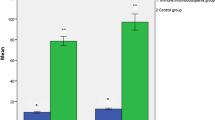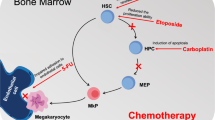Abstract
Background and objectives
Oxidative stress in drug-induced thrombocytopenia (TP) has been discussed. This study was carried out to assess the oxidative stress in patients with normal platelet count (NPC) and TP after linezolid (LZD) treatment and to evaluate if TP caused by LZD is associated with a reduction in antioxidation ability and an increase in lipid peroxidative product in platelets.
Methods
After LZD treatment for 20 days, 44 patients with TP and 73 patients with NPC were included in this study. Blood samples were collected on the day before medicine treatment and day 7, 14, and 20 after LZD therapy. Levels of reactive oxygen species (ROS), malondialdehyde (MDA), and cholesterol as well as the activities of antioxidative enzyme were estimated. In addition, we identified 37 patients with TP caused by low-dose methotrexate (7.5–25 mg/week) therapy as a positive control group.
Results
In total, 37.60 % of cases presented with TP on the 20th day of LZD administration. Individuals with TP had significantly elevated levels of ROS and MDA, low levels of superoxide dismutase (SOD) and catalase (CAT), significantly decreased high-density lipoprotein-cholesterol, low-density lipoprotein (LDL)-cholesterol levels, and increased oxidized-LDL levels in comparison to individuals with NPC. However, no significant changes in the levels of glutathione-peroxidase were found in the course of time. In all cases with LZD, significant increases in levels of ROS, MDA, and ox-LDL were found in the 20-day samples compared with their respective samples before LZD treatment. Correlation analysis revealed a positive association between platelet count and levels of SOD on day 20 and CAT on days 14 and 20 in plasma, a negative association between platelet count and level of MDA and ROS on days 14 and 20 in patients with LZD-induced TP.
Conclusions
The oxidative stress markers were increased in LZD-induced TP, suggesting that oxidative damage might be the underlying mechanism.


Similar content being viewed by others
References
Waldrep TW, Skiest DJ. Linezolid-induced anemia and thrombocytopenia. Pharmacotherapy. 2002;22:109–12.
Bouza E. New therapeutic choices for infections caused by methicillin-resistant Staphylococcus aureus. Clin Microbiol Infect. 2009;7:44–52.
Bishop E, Melvani S, Howden BP, et al. Good clinical outcomes but high rates of adverse reactions during linezolid therapy for serious infections: a proposed protocol for monitoring therapy in complex patients. Antimicrob Agents Chemother. 2006;50:1599–602.
Minson Q, Gentry CA. Analysis of linezolid-associated hematologic toxicities in a large Veterans Affairs medical center. Pharmacotherapy. 2010;30:895–903.
Pascoalinho D, Vilas MJ, Coelho L, et al. Linezolid-related immune-mediated severe thrombocytopenia. Int J Antimicrob Agents. 2011;37:88–9.
Tsuji Y, Hiraki Y, Matsumoto K, et al. Thrombocytopenia and anemia caused by a persistent high linezolid concentration in patients with renal dysfunction. J Infect Chemother. 2011;17:70–5.
Zyvox (linezolid) [package insert]. Kalamazoo, MI: Pharmacia & Upjohn Company, 2002.
Attassi K, Hershberger E, Alam R, et al. Thrombocytopenia associated with linezolid therapy. Clin Infect Dis. 2002;34:695–8.
Orrick JJ, Johns T, Janelle J, et al. Thrombocytopenia secondary to linezolid administration: what is the risk? Clin Infect Dis. 2002;35:348–9.
Niwa T, Suzuki A, Sakakibara S, et al. Retrospective cohort chart review study of factors associated with the development of thrombocytopenia in adult Japanese patients who received intravenous linezolid therapy. Clin Ther. 2009;31:2126–33.
Chen C, Guo DH, Cao X, et al. Risk factors for thrombocytopenia in adult Chinese patients receiving linezolid therapy. Curr Ther Res Clin Exp. 2012;73:195–206.
Takahashi Y, Takesue Y, Nakajima K, et al. Risk factors associated with the development of thrombocytopenia in patients who received linezolid therapy. J Infect Chemother. 2011;17:382–7.
Natsumoto B, Yokota K, Omata F, et al. Risk factors for linezolid-associated thrombocytopenia in adult patients. Infection. 2014;42:1007–12.
Green SL, Maddox JC, Huttenbach ED. Linezolid and reversible myelosuppression. JAMA. 2001;285:1291.
Bernstein WB, Trotta RF, Rector JT, et al. Mechanisms for linezolid-induced anemia and thrombocytopenia. Ann Pharmacother. 2003;37:517–20.
Senneville E, Legout L, Valette M, et al. Risk factors for anaemia in patients on prolonged linezolid therapy for chronicosteomyelitis: a case-control study. J Antimicrob Chemother. 2004;54:798–802.
Youssef S, Hachem R, Chemaly RF, et al. The role of vitamin B6 in the prevention of haematological toxic effects of linezolid in patients with cancer. J Antimicrob Chemother. 2008;61:421–4.
Soundravally R, Sankar P, Hoti SL, et al. Oxidative stress induced changes in plasma protein can be a predictor of imminent severe dengue infection. Acta Trop. 2008;106:156–61.
Percário S, Moreira DR, Gomes BA, et al. Oxidative stress in malaria. Int J Mol Sci. 2012;13:16346–72.
Kim EJ, Lim KM, Kim KY, et al. Doxorubicin-induced platelet cytotoxicity: a new contributory factor for doxorubicin-mediated thrombocytopenia. J Thromb Haemost. 2009;7:1172–83.
Beck MA, Handy J, Levander OA. The role of oxidative stress in viral infections. Ann N Y Acad Sci. 2000;917:906–12.
Freedman JE. Oxidative stress and platelets. Arterioscler Thromb Vasc Biol. 2008;28:s11–6.
Zhang B, Zehnder JL. Oxidative stress and immune thrombocytopenia. Semin Hematol. 2013;50:e1–4.
Araujo CF, Lacerda MV, Abdalla DS. The role of platelet and plasma markers of antioxidant status and oxidative stress in thrombocytopenia among patients with vivax malaria. Mem Inst Oswaldo Cruz. 2008;103:517–21.
Kuter DJ, Tillotson GS. Hematologic effects of antimicrobials: focus on the oxazolidinone linezolid. Pharmacotherapy. 2001;21:1010–3.
Yu BP. Cellular defenses against damage from reactive oxygen species. Physiol Rev. 1994;74:139–62.
Coopamah MD, Garvey MB, Freedman J, et al. Cellular immune mechanisms in autoimmune thrombocytopenic purpura. Transfus Med Rev. 2003;17:69–80.
Clark IA, Hunt NH. Evidence for reactive oxygen intermediates causing hemolysis and parasite death in malaria. Infect Immun. 1983;39:1–6.
Wang Z, Cai F, Chen X, et al. The role of mitochondria-derived reactive oxygen species in hyperthermia-induced platelet apoptosis. PLoS One. 2013;8:e75044.
Chen S, Su Y, Wang J. ROS-mediated platelet generation: a microenvironment-dependent manner for megakaryocyte proliferation, differentiation, and maturation. Cell Death Dis. 2013;4:e722.
Nielsen F, Mikkelsen BB, Nielsen JB, et al. Plasma malondialdehyde as biomarker for oxidative stress: reference interval and effects of life-style factors. Clin Chem. 1997;43:1209–14.
Erel O, Kocyigit A, Avci S, et al. Oxidative stress and antioxidative status of plasma and erythrocytes in patients vith vivax malaria. Clin Biochem. 1997;30:631–9.
Badimon JJ, Badimon L, Turitto VT, et al. Platelet deposition at high shear rates is enhanced by high plasma cholesterol levels: in vivo study in the rabbit model. Arterioscler Thromb. 1991;11:395–402.
Relou IA, Hackeng CM, Akkerman JW, et al. Low-density lipoprotein and its effect on human blood platelets. Cell Mol Life Sci. 2003;60:961–71.
Davì G, Averna M, Catalano I, et al. Increased thromboxane biosynthesis in type IIa hypercholesterolemia. Circulation. 1992;85:1792–8.
Seno T, Inoue N, Gao D, et al. Involvement of NADH/NADPH oxidase in human platelet ROS production. Thromb Res. 2001;103:399–409.
Bachar AR, Scheffer L, Schroeder AS, et al. Humanin is expressed in human vascular walls and has a cytoprotective effect against oxidized LDL-induced oxidative stress. Cardiovasc Res. 2010;88:360–6.
Linden PK. Treatment options for vancomycin-resistant enterococcal infections. Drugs. 2002;62:425–41.
Anger HA, Dworkin F, Sharma S, et al. Linezolid use for treatment of multidrug-resistant and extensively drug-resistant tuberculosis, New York City, 2000–06. J Antimicrob Chemother. 2010;65:775–83.
Pietrantonio F, Di Bartolomeo M, Buzzoni R, et al. Acute immune-mediated thrombocytopenia due to oxaliplatin administration: a case report. Tumori. 2010;96:154–6.
Nguyen TC, Carcillo JA. Dietary virgin olive oil reduces oxidative stress and cellular damage in rat brain slices subjected to hypoxia-reoxygenation. Crit Care. 2006;10:235.
Cho YS, Kim MJ, Lee JY, et al. The role of thiols in protecting against simultaneous toxicity of menadione to platelet plasma and intracellular membranes. J Pharmacol Exp Ther. 1997;280:1335–40.
Spellberg B, Yoo T, Bayer AS. Reversal of linezolid-associated cytopenias, but not peripheral neuropathy, by administration of vitamin B6. J Antimicrob Chemother. 2004;54:832–5.
Wang T, Guo D, Dong X, et al. Effect of linezolid on hematological and oxidative parameters in rats. J Antibiot. 2014;67:433–7.
Acknowledgments
This study was supported by the major national science and technology special projects for new drugs (No. 2012ZX09303004-002). We also thank all editors and reviewers for helpful suggestions that improved this manuscript.
Author Contributions
Conceived and designed the study: WR G-DH. Performed the studies: W-TL, BY, WK. Analyzed the data: W-TL. Contributed reagents/materials/analysis tools: WR G-DH, W-HL. Wrote the paper: W-HL, H-WY. Language corrections: H-WY. W-TL and G-DH contribute equally to this work.
Author information
Authors and Affiliations
Corresponding author
Ethics declarations
This study was approved by the Ethics Committee of the PLA General Hospital, China, and written informed consent was obtained from all patients and volunteers.
Rights and permissions
About this article
Cite this article
Wang, TL., Guo, DH., Bai, Y. et al. Thrombocytopenia in Patients Receiving Prolonged Linezolid May be Caused by Oxidative Stress. Clin Drug Investig 36, 67–75 (2016). https://doi.org/10.1007/s40261-015-0352-0
Published:
Issue Date:
DOI: https://doi.org/10.1007/s40261-015-0352-0




